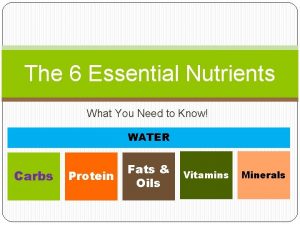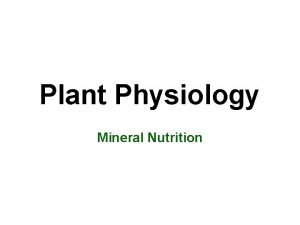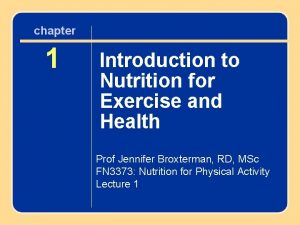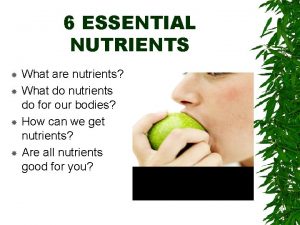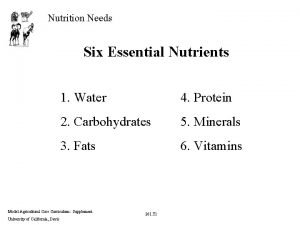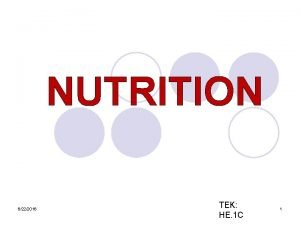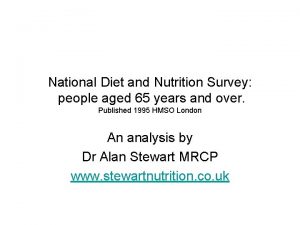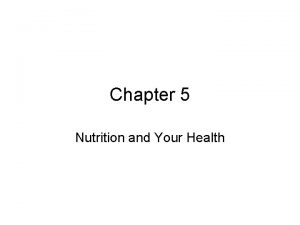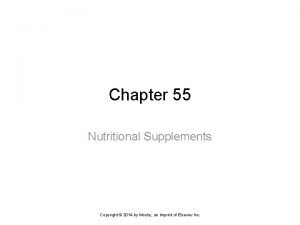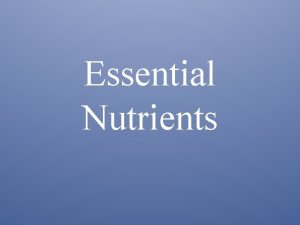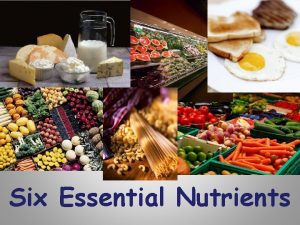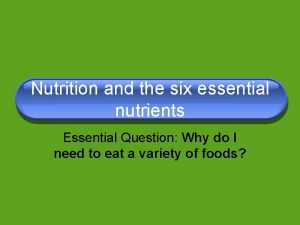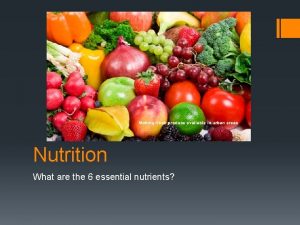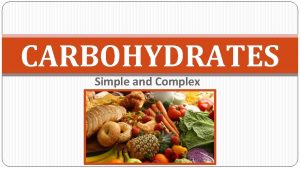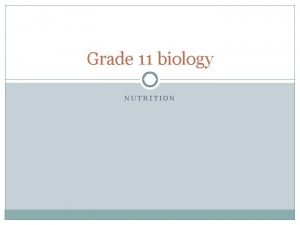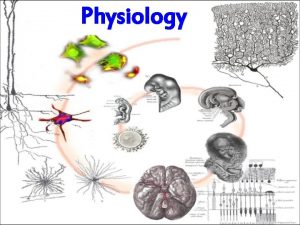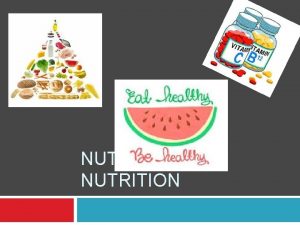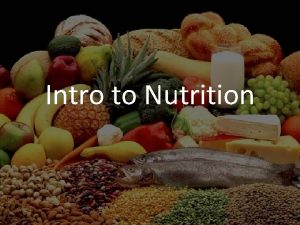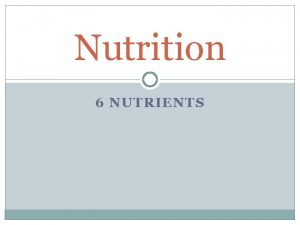Nutrition and health The essential nutrients Nutrients organic
















- Slides: 16

Nutrition and health. .

The essential nutrients • Nutrients: organic and inorganic substances found in food that are required by the body for the growth and maintenance of body systems. • Macronutrients: large molecules needed by the body in large amounts • Micronutrients: small molecules needed by the body in small amounts. • The essential nutrients include protein, carbohydrates, fats, water, vitamins and minerals

Digestion of food • Digestion is the breakdown of food from larger molecules to smaller molecules through the action of enzymes. • An enzyme is a protein based chemical that allows the chemical reactions involved in digestion to take place. • Digestion begins in the mouth and ends in the large intestine.

Digestion of nutrients Nutrient Part of digestive system Absorbable nutrient Carbohydrates (CHO) Mouth, stomach & small intestine Glucose Proteins Stomach & small intestine Amino acids Lipids (fats) Small intestine Fatty Acids Water Large Intestine Water

Nutrient functions – Macronutruients • Carbohydrates: – Carbohydrates (CHO-) are the preferred energy source for the body and provide 17 kj per gram. – Generally divided into 2 groups; simple (sugars) found in honey and fruit and complex (starches) found naturally in vegetables and grains.

Simple Carbohydrates • Monosaccharide's – simple form of sugar (EG glucose & fructose) • Disaccharides – made up of two monosaccharide's (EG sucrose, lactose and maltose)

Complex carbohydrates • Polysaccharide’s – large molecules of one or more types of monosaccharide unit. Glycogen = 10 monosaccharide units. • Glycaemic index – ranks foods on how they affect blood sugar levels. • Foods are given a score out of 100 – white bread is the control with a GI of 70.

Glycaemic index

Glycaemic index (G. I. ) • Relates to the ranking of carbohydrate foods according to the effect these foods have on blood glucose levels • Foods with a low GI carbohydrate ranking are broken down more slowly by the body and result in a gradual rise in blood sugar level; in other words they provide more sustained energy • Foods with a high GI carbohydrate ranking are broken down more quickly by the body and result in a rapid increase in blood sugar levels, but do not provide sustained energy

Glycaemic Index over time

G. I. grading scale • Foods are ranked between 0 -100, where glucose is determined at 100 • Low G. I. foods = less than 55 • Medium G. I. foods = between 56 -69 • High G. I. = foods more than 70

Low G. I. vs. high G. I. • Low GI foods: are recommended for people with type 2 diabetes as they provide more control over blood glucose levels • High GI foods: may be suitable for sportspeople who need a rapid source of glucose to replenish or re-fuel hard working muscles

Examples of GI foods Food Low GI Medium GI High GI Bread Pumpernickel 41 Mixed grain 30 -45 Sourdough 57 Rye 65 White 70 Wholemeal 72 Breakfast cereals All bran 42 Toasted muesli 43 Muesli 66 Cornflakes 84 Rice bubbles 82 Vegetables Carrots 41 Dairy foods Milk full fat 27 Milk skim 32 Yoghurt 33 Ice cream 61 Fruit Apple 36 Orange 43 Banana 58 Pineapple 66 Watermelon 72 Rice Long grain 50 Basmati 50 – 60 White 70 – 80 Confectionery Milk choc 49 M&M’s 33 Mars bar 65 Jelly beans 80 Life savers 70 Potatoes 80+

How do I know if something is low G. I. ? The new GI Symbol still carries the same trusted credentials as the old one, and the products that carry the Symbol still meet the same strict nutrition criteria - but now it’s even easier for people to shop for themselves and their families and choose foods to help them follow a healthy diet. Foods and drinks carrying this symbol: • Meet strict nutrition criteria for energy (calories/kilojoules), fat, saturated fat, sodium, and where appropriate, dietary fibre and calcium • Help maintain a healthy body weight • Help manage blood glucose (sugar) levels • Reduce the risk of diabetes and heart disease


Task • Using the website www. glycaemicindex. com and your 24 hour food diary, list the G. I. rankings of all food consumed • Work out the average G. I. of the foods eaten • Write a report outlining suggestions to your day’s diet that might promote health
 Chapter 10 lesson 2 nutrients
Chapter 10 lesson 2 nutrients Organic and inorganic nutrients
Organic and inorganic nutrients 6 essential nutrients and their functions
6 essential nutrients and their functions Sunflower bud
Sunflower bud Essential vs nonessential nutrients
Essential vs nonessential nutrients Essential vs nonessential nutrients
Essential vs nonessential nutrients In pku which amino acid becomes conditionally essential
In pku which amino acid becomes conditionally essential Dri
Dri What are 6 essential nutrients
What are 6 essential nutrients Six essential nutrients
Six essential nutrients Nutrients
Nutrients Classification of essential nutrients
Classification of essential nutrients Characteristics of lipids
Characteristics of lipids Chapter 5 lesson 1 health
Chapter 5 lesson 1 health Project title for health and nutrition
Project title for health and nutrition Chapter 55 nutrition and health
Chapter 55 nutrition and health Core functions and essential services of public health
Core functions and essential services of public health


